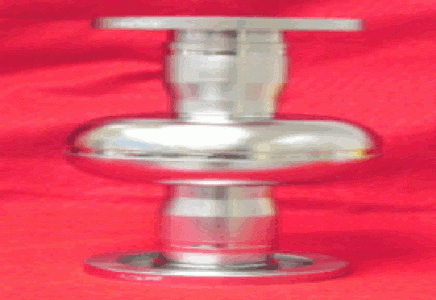SRF Cavities from Single-Crystal Niobium

This single cell cavity was made from a single crystal of niobium. Made in the same shape as the low-loss design proposed as an improvement to the baseline for the International Linear Collider (ILC), this cavity performs much better than the ILC design goal.
Additional Links
A potentially cost-saving and performance-enhancing new approach to fabricating superconducting radiofrequency (SRF) accelerating cavities has been demonstrated by the Institute for Superconducting Radiofrequency Science & Technology (ISRFST) at Jefferson Lab. Several single-cell niobium cavities were made from material sliced from large-grain niobium ingots, rather than fine-grain material melted from ingots and formed into sheets by the traditional process of forging, annealing, rolling and chemical etching. In tests carried out by ISRFST, these cavities performed extremely well. If multi-cell cavities are also successful, the method could have a substantial impact on the economics of high-performance SRF—notably including for the ILC, the International Linear Collider, a 500 GeV machine that will need some 17,000 SRF cavities performing above 28 MV/m. This proof-of-principle work could lead to more reliable production and reduced costs.
Using a scaled version of a low-loss design proposed for the ILC, a test cavity supported an accelerating gradient of 45 MV/m. This figure is very close to both Cornell's current world record and the theoretical limit.
The work aimed to provide a deeper understanding of the influence of grain boundaries on the often-observed drop in Q (the cavity-performance quality factor) at accelerating gradients above 20 MV/m. "Q-drop" is not well understood, but it may be linked to contaminants and grain boundaries in the niobium.
The researchers used single-crystal niobium sheets for forming into half-cells, omitting expensive processing steps and producing cavities with few or no grain boundaries. Reference Metals Company Inc of Bridgeville, Pennsylvania, provided the niobium in a research collaboration with JLab.
Reference
P. Kneisel et al., "Preliminary Results from Single Crystal and Very Large Crystal Niobium Cavities" 2005 Particle Accelerator Conference

